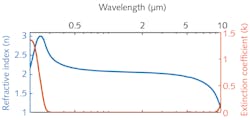Waveguide-based integrated photonics can be based on a number of different optical materials, including silicon, indium phosphide, polymers, glass (including chalcogenides), and silicon nitride. Some materials have advantages for certain purposes: for example, silicon nitride has a high nonlinear index, making it suitable for nonlinear optical processes (such as continuum generation from laser input). Some of these materials have the advantage of being compatible with CMOS fabrication processes, making them suitable for inexpensive large-scale production. Now, researchers at the National Institute of Standards and Technology (NIST; Boulder, CO) are exploring the uses of a new material, tantalum pentoxide (Ta2O5, or tantala), which they say is a promising CMOS-compatible nonlinear-optical material with desirable mechanical and linear-optical properties as well.
The researchers characterized both the broadband refractive index and extinction coefficient of tantala. The material is transparent from 320 nm in the ultraviolet to 8 μm in the infrared, with a real refractive index of a little over 2 over most of this range, making it well suited for tightly confined waveguiding. Using finite-element electromagnetic field simulations of nanophotonic waveguides, the researchers calculated the group-velocity dispersion (GVD) for various waveguide cross-section geometries of tantala on silicon dioxide with air cladding for the other waveguide sides; some geometries led to anomalous GVD, which is desirable for nonlinear effects. They then fabricated supercontinuum-generation waveguides and ring resonators with top air cladding (although tantala’s high index makes oxide cladding possible, too); the waveguide propagation losses were as low as 0.1 dB/cm.
Pulsed laser light with a 1560 nm wavelength, repetition rate of 100 MHz, and pulse duration of 80 fs was coupled into a tantala waveguide via a microscope objective lens; light was collected from the waveguide’s other end with a multimode fiber. The resulting supercontinuum for a first prototype waveguide with 1.6 μm width spanned the 800–2500 nm spectral range. More-complex waveguide designs can increase the supercontinuum bandwidth, say the researchers. Prototype tantala ring resonators had quality factors (Q) of 1 × 106. Reference: J. A. Black et al., Opt. Lett. (2021); https://doi.org/10.1364/ol.414095.

John Wallace | Senior Technical Editor (1998-2022)
John Wallace was with Laser Focus World for nearly 25 years, retiring in late June 2022. He obtained a bachelor's degree in mechanical engineering and physics at Rutgers University and a master's in optical engineering at the University of Rochester. Before becoming an editor, John worked as an engineer at RCA, Exxon, Eastman Kodak, and GCA Corporation.
